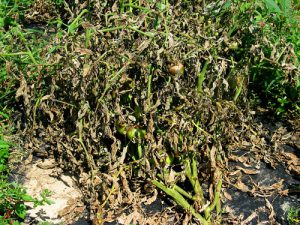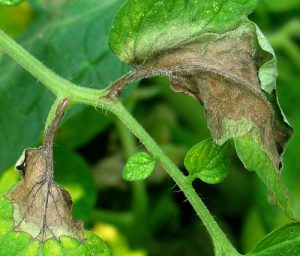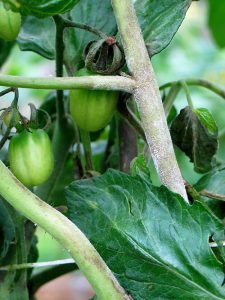Watching out for late blight disease on tomato plants in Miami-Dade County is critically important! An outbreak of late blight disease on tomato could be a critical concern because of the low temperature and high humidity. Up to now, UF/IFAS faculty have reported incidents from Southern Hillsborough County and the Immokalee area. Very recently, the disease has appeared on potatoes as well.
Late blight – a fatal disease
The fungus-like ‘oomycete’ Phytophthora infestans causes late blight as a pathogen of potato and tomato. This disease can spread quickly and devastate a tomato field within a few weeks if it spreads (see the picture below).

Weather related disease
Late blight disease usually thrives under cool and wet conditions. Temperatures at 50° – 80° F together with wet conditions are ideal for the disease development. For instance, if there is prolonged rain, fog, heavy dew, or relative humidity is 90%. It is ideal especially if night temperatures are in the mid-fifties with daytime temperatures from the mid-fifties to mid-seventies.
Symptoms of late blight
Late blight symptoms on leaves appear as irregularly shaped brown to purplish lesions with indefinite border lesions that can span veins (see the picture below). You may see the lesions any time of day, on any stage of plant growth. Some velvety, white fungal growth may appear on the lower surface of affected leaflets in early morning or before leaves dry.

On the stems, purplish lesions may appear with cottony and white growth of fungus in early morning or in the lower canopy (see the picture below). Stems with lesions are brittle and break easily. Lesions are confined to epidermis and cortex. Leaf rolling and wilting with stem lesions and purpling of leaflets may occur in some varieties.

Control and preventive measures
To control this fatal disease, start a spray program with fungicides if late blight is in the area or weather conditions are suitable for late blight development. After harvest, kill infected foliage to minimize further infection. Because the disease can spread so rapidly, tomato growers should scout their fields thoroughly each day. It is especially important under cool and wet weather conditions.
Currently, fungicides are the most effective means of controlling late blight. Certain fungicides can reduce the spread rate because they create a protective barrier on the foliage. Prevention is a top priority, tomato growers may apply chlorothalonil before the incidence occurs.
Available fungicides and usage (follow the label for application)
|
|||||||||||||||||||||||||||||||||||||||||||||||||||||||||||||||||
For more information about late blight, see USA Blight with more photos:
– What is Late Blight Disease
References
Margaret McGrath, 2018. Late blight on tomatoes, Vegetable Pathology – Long Island Horticultural Research & Extension Center, Cornel University. http://blogs.cornell.edu/livegpath/gallery/tomato/tomato-late-blight/
Eugen McAvoy, 2018. Late blight found in Immokalee, email communication.
 0
0
